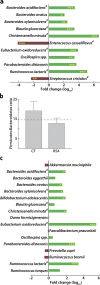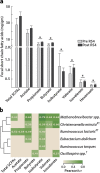Impact of dietary resistant starch type 4 on human gut microbiota and immunometabolic functions
- PMID: 27356770
- PMCID: PMC4928084
- DOI: 10.1038/srep28797
Impact of dietary resistant starch type 4 on human gut microbiota and immunometabolic functions
Abstract
Dietary modulation of the gut microbiota impacts human health. Here we investigated the hitherto unknown effects of resistant starch type 4 (RS4) enriched diet on gut microbiota composition and short-chain fatty acid (SCFA) concentrations in parallel with host immunometabolic functions in twenty individuals with signs of metabolic syndrome (MetS). Cholesterols, fasting glucose, glycosylated haemoglobin, and proinflammatory markers in the blood as well as waist circumference and % body fat were lower post intervention in the RS4 group compared with the control group. 16S-rRNA gene sequencing revealed a differential abundance of 71 bacterial operational taxonomic units, including the enrichment of three Bacteroides species and one each of Parabacteroides, Oscillospira, Blautia, Ruminococcus, Eubacterium, and Christensenella species in the RS4 group. Gas chromatography-mass spectrometry revealed higher faecal SCFAs, including butyrate, propionate, valerate, isovalerate, and hexanoate after RS4-intake. Bivariate analyses showed RS4-specific associations of the gut microbiota with the host metabolic functions and SCFA levels. Here we show that dietary RS4 induced changes in the gut microbiota are linked to its biological activity in individuals with signs of MetS. These findings have potential implications for dietary guidelines in metabolic health management.
Figures






References
Publication types
MeSH terms
Substances
Grants and funding
LinkOut - more resources
Full Text Sources
Other Literature Sources

